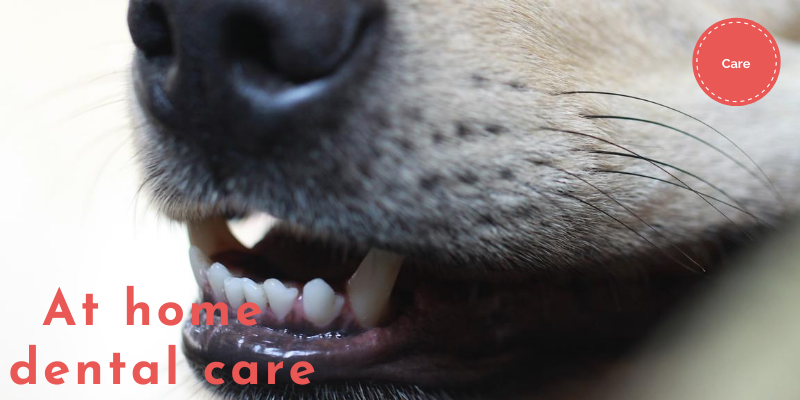
Have you ever received a big sloppy kiss from your pet only to have you dry retching and thinking “oh your breath stinks!”. This is a very good indication that your pet is in some serious need of dental care. Don’t worry though, you are not alone as Periodontal disease is quite common with studies showing that approximately 80% of dogs and 70% of cats over the age of 3 years have some form of dental disease.
Dental disease, also known as periodontal disease, is when a build-up of plaque has caused your pet’s teeth and gums to become inflamed. Plaque, which is made up of saliva, bacteria, and food particles, when not removed, can calcify into tartar thus causing complications for our furry friends. Infections and serious illness can accompany dental disease so we must be aware of how our pet’s teeth and gums are looking.
What are the signs of dental disease
There are many signs that can indicate that our pet’s gums and teeth are not as healthy as they maybe should be. These can include:
- Bad breath
- Drooling
- Inappetence (lack of appetite)
- Pawing at their mouth
- Bleeding gums
- An obvious build-up of tartar on the teeth
- Loose teeth
- Swelling around the facial area
- Behaviour changes i.e lethargic or becoming aggressive when touched around the face
There are many ways in which we can assist in preventing dental disease or even slow the process of it developing. Many of these methods can be done in the comfort of your own home.
Brushing teeth
Brushing your pet’s teeth may seem like a crazy idea to some, and it is obvious to say, not all pets will allow you to do this, however, it is the most effective way to help in preventing dental disease. So I would always recommend at least giving it a go.
If you decide that you would like to start brushing your pet’s teeth, you must make sure you commit to doing this as part of your daily routine. Plaque can build-up on a healthy tooth within 3-5 days so by carrying this out only sporadically, you risk tartar build-up, gingivitis, and further issues. There are a couple of steps you should follow to be able to successfully brush your pet’s teeth.
- It is important to pick a good time and place. When your pet is at his most active is probably not going to lead to a successful outcome as it could potentially end up with you feeling frustrated and your pet enjoying a game. Pick a calm and quiet place when your pet is at their most relaxed. Of a night when they are curled up next to you watching TV would suggest a better time to start.
- Start by touching their muzzle and gums with your hands before introducing a brush. By placing a nice treat on the end of your finger (my pets love peanut butter) will make the experience rewarding and pleasant. It is important to take your time with this step, do not push your pet or try restraining them to the point it becomes a fight. Make the sessions short and sweet and mostly positive.
- Introduce a nice soft toothbrush. Most vets and large pet stores will sell toothbrushes specially designed for pets. In saying this a toddler’s toothbrush can work just as well. Most importantly, use a toothpaste specially made for pets, NEVER use human toothpaste as this can potentially make your pet very unwell.
- Brushing your pet’s teeth is similar to brushing our own, only it requires you to do so for approximately 30 seconds on each side of the mouth. Ensure you are using circular motions and apply gentle pressure on each tooth and along the gum line. REMEMBER the back teeth!
If this is just never going to happen then don’t worry there are alternatives to brushing your pet’s teeth.
Treats and Chews are a fun and positive alternative to brushing teeth, however, they can not be relied on solely to prevent dental disease. Premium treats such as Greenies which are made from natural ingredients and are designed with a unique texture that assists in fighting plaque and tartar.
Dental diets
There are many options when it comes to finding a premium pet dry food and treats designed to assist in preventing dental disease. For example, Hills Science Diet T/D has been scientifically designed to promote healthy teeth and gums with not only its ingredients but also the design of the kibble. As always, however, it is best to speak to your veterinarian to decide which diet is best suited to your pet. Specifically designed dental food should contain ingredients that are similar to what we find in toothpaste thus helping to slow the build-up of plaque forming on the teeth and slow the disease.
Dental toys
There is an endless amount of toys that claim to help prevent dental disease. Toys are a great option as they encourage chewing and thus can assist in preventing the build-up of plaque.
Gels, rinses, and sprays
These can assist in promoting overall good oral hygiene as well as giving our pet a nice fresh breath.
As always it is best to consult with your veterinarian regarding your pet’s oral health. Vets may recommend that your pet come in for a dental scale and polish before beginning any dental regime to ensure you have the best chance of maintaining not only your pet’s oral hygiene but also their overall health.
The information on PuppyPages website is not meant to replace first hand treatment of your dog by a professional vet. Always consult your vet for medical and health care advice. You should not rely on any of the information on this website for medical diagnosis, treatment options or other health care decisions about your pet. When possible we have articles fact checked by experienced Vets and Vet Nurses. Read full Disclaimer here
